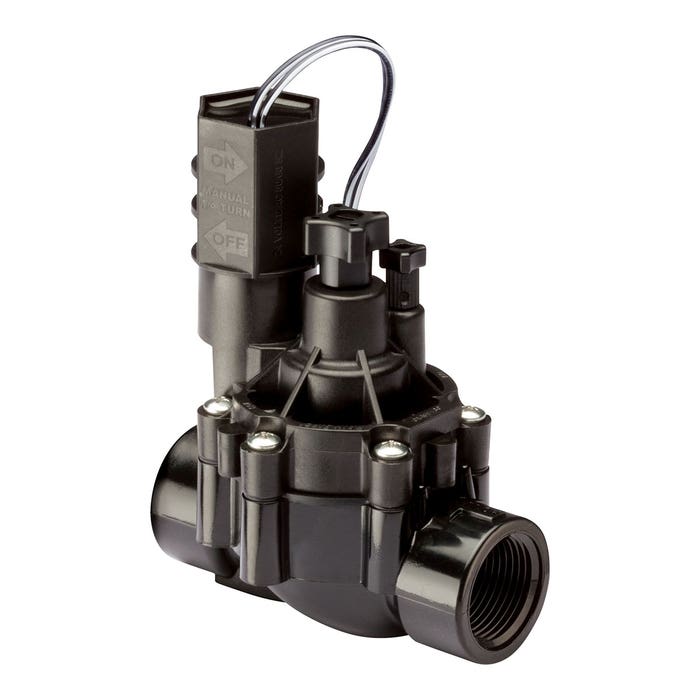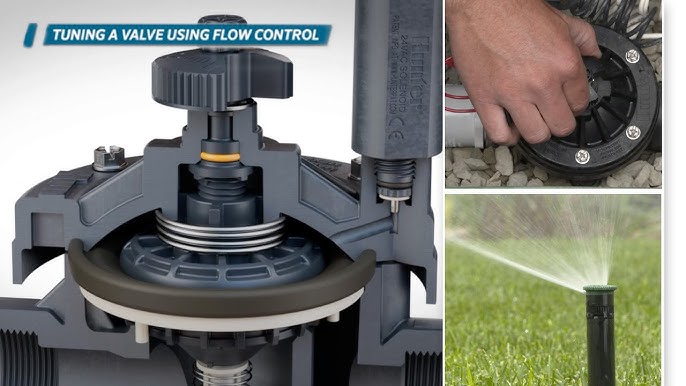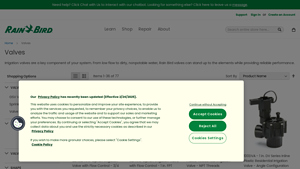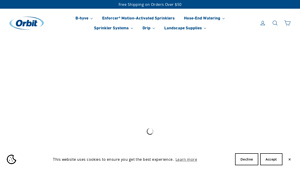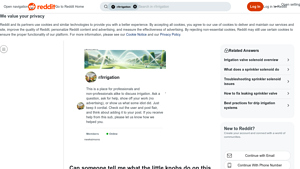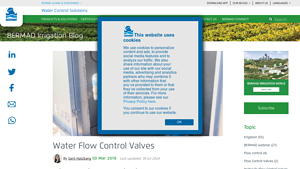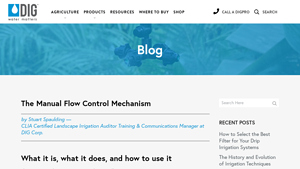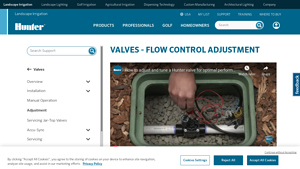Introduction: Navigating the Global Market for flow control valve irrigation
The complexity of sourcing flow control valve irrigation systems presents a significant challenge for international B2B buyers, particularly in regions such as Africa, South America, the Middle East, and Europe. As agricultural practices evolve and water conservation becomes increasingly critical, selecting the right flow control valves can directly impact operational efficiency and sustainability. This guide delves into the intricacies of the global market for flow control valves, covering various types, applications, and essential considerations for supplier vetting.
In this comprehensive resource, buyers will gain insights into the latest advancements in flow control technology, from manual to automated systems, and understand their applications in both residential and commercial settings. We will also explore crucial factors such as pricing structures, warranty considerations, and regulatory compliance—elements vital for making informed purchasing decisions.
By equipping B2B buyers with actionable knowledge and strategic insights, this guide empowers stakeholders to navigate the complexities of the irrigation valve market confidently. Whether you’re sourcing products from Vietnam or Germany, our expertise will facilitate smarter procurement processes, ensuring that you select the most suitable solutions to enhance your irrigation systems. Prepare to transform your purchasing approach and maximize your investment in flow control valve irrigation.
Understanding flow control valve irrigation Types and Variations
| Type Name | Key Distinguishing Features | Primary B2B Applications | Brief Pros & Cons for Buyers |
|---|---|---|---|
| Inline Flow Control Valves | Installed directly in the pipeline; allows for easy flow adjustment and maintenance; typically features a manual bleed screw for debris removal. | Agricultural irrigation, landscaping | Pros: Easy installation and maintenance; versatile for various systems. Cons: May require regular checks to ensure optimal performance. |
| Anti-Siphon Valves | Prevents backflow to protect the water supply; includes a built-in vacuum breaker; suitable for residential and commercial applications. | Residential irrigation, commercial landscaping | Pros: Enhances water safety; reduces contamination risks. Cons: Slightly more complex installation; may be pricier. |
| Pressure Regulating Valves | Maintains consistent downstream pressure; suitable for varying inlet pressures; protects irrigation systems from pressure fluctuations. | Commercial agriculture, golf courses | Pros: Ensures uniform water distribution; extends equipment life. Cons: Higher initial investment; may require professional installation. |
| Drip Irrigation Control Valves | Specifically designed for low-flow applications; minimizes water waste through targeted delivery; often features built-in filters to reduce clogging. | Greenhouses, high-value crops | Pros: Highly efficient water usage; customizable for different crops. Cons: Requires careful planning and installation. |
| Zone Control Valves | Allows for segmentation of irrigation systems; enables independent control of different areas; can be automated for efficiency. | Large agricultural fields, parks | Pros: Improved water management; enhanced system flexibility. Cons: Complexity in setup; potential for increased maintenance. |
What Are Inline Flow Control Valves and Where Are They Best Used?
Inline flow control valves are a fundamental component in irrigation systems, designed to be integrated directly into the pipeline. They allow for easy adjustments to water flow and feature a manual bleed screw that facilitates the removal of debris, ensuring efficient operation. These valves are particularly suitable for agricultural irrigation and landscaping projects. B2B buyers should consider the ease of installation and maintenance, though they may require regular inspections to maintain optimal performance.
How Do Anti-Siphon Valves Protect Water Supply?
Anti-siphon valves are crucial for preventing backflow, thereby safeguarding the water supply from contamination. They incorporate a vacuum breaker and are ideal for both residential and commercial irrigation applications. These valves are particularly beneficial in regions with strict water quality regulations. While they enhance safety and reduce contamination risks, buyers should be aware of their more complex installation requirements and potentially higher costs compared to standard valves.
Why Choose Pressure Regulating Valves for Irrigation Systems?
Pressure regulating valves are designed to maintain a consistent downstream pressure, making them essential for environments with varying inlet pressures. This feature protects irrigation systems from pressure fluctuations that can lead to uneven water distribution. They are particularly advantageous for commercial agriculture and golf courses. Although they ensure uniform water delivery and extend the life of irrigation equipment, buyers must consider the higher initial investment and the potential need for professional installation.
What Are the Benefits of Drip Irrigation Control Valves?
Drip irrigation control valves are tailored for low-flow applications, allowing for precise water delivery directly to the plant roots. This design minimizes water waste, making them an excellent choice for greenhouses and high-value crops. Additionally, many models include built-in filters to reduce clogging, enhancing their efficiency. B2B buyers should weigh the benefits of efficient water usage against the need for careful planning and installation to optimize their irrigation systems.
How Do Zone Control Valves Enhance Irrigation Management?
Zone control valves facilitate the segmentation of irrigation systems, enabling independent control of different areas within a landscape or agricultural field. This feature allows for more efficient water management and can be automated for added convenience. They are particularly useful in large agricultural fields and parks. However, while they enhance system flexibility, buyers should be prepared for the complexity of setup and the potential for increased maintenance requirements.
Key Industrial Applications of flow control valve irrigation
| Industry/Sector | Specific Application of Flow Control Valve Irrigation | Value/Benefit for the Business | Key Sourcing Considerations for this Application |
|---|---|---|---|
| Agriculture | Precision irrigation systems for crop cultivation | Optimizes water usage, enhancing crop yield and quality | Durability, compatibility with existing systems, local regulations |
| Landscape Management | Automated irrigation for parks and public spaces | Reduces labor costs and ensures consistent watering | Ease of installation, adaptability to varying soil types |
| Horticulture | Drip irrigation for greenhouses | Efficient water delivery minimizes waste and maximizes growth | Flow rate specifications, resistance to clogging, material quality |
| Industrial Applications | Cooling systems in manufacturing processes | Maintains optimal temperatures, improving efficiency | Pressure ratings, energy efficiency, maintenance requirements |
| Municipal Water Systems | Backflow prevention in urban irrigation systems | Protects potable water supply from contamination | Compliance with local regulations, reliability, ease of maintenance |
How is Flow Control Valve Irrigation Used in Agriculture?
In the agriculture sector, flow control valves are integral to precision irrigation systems, allowing for tailored water delivery based on crop needs. This optimizes water usage, leading to increased crop yield and quality. For international buyers, especially in regions with water scarcity like parts of Africa and the Middle East, sourcing durable valves that can withstand local environmental conditions is crucial. Compatibility with existing irrigation infrastructure and adherence to local agricultural regulations are also key factors.
What Role Do Flow Control Valves Play in Landscape Management?
Flow control valves are widely used in landscape management for automated irrigation systems that service parks and public spaces. By regulating water flow, these valves reduce labor costs and ensure consistent watering, which is vital for maintaining aesthetic and environmental standards. Buyers should consider the ease of installation and adaptability of these valves to varying soil types, especially in diverse climates across Europe and South America.
Why Are Flow Control Valves Essential in Horticulture?
In horticulture, particularly within greenhouse environments, flow control valves facilitate drip irrigation systems that deliver water efficiently directly to plant roots. This method minimizes waste and promotes optimal plant growth. Buyers must focus on specifications such as flow rates, resistance to clogging, and the quality of materials used to ensure longevity and effectiveness in varying climates, including humid regions like Vietnam.
How Do Flow Control Valves Benefit Industrial Applications?
Flow control valves are crucial in industrial applications, particularly in cooling systems within manufacturing processes. These valves help maintain optimal temperatures, thereby improving operational efficiency and reducing costs associated with overheating. Key sourcing considerations for businesses include pressure ratings, energy efficiency, and maintenance requirements, ensuring the selected valves can handle specific industrial demands effectively.
What is the Importance of Flow Control Valves in Municipal Water Systems?
In municipal water systems, flow control valves are essential for backflow prevention in urban irrigation systems. They protect potable water supplies from contamination, a critical concern for public health and safety. Buyers should prioritize compliance with local regulations, reliability, and ease of maintenance when sourcing these valves to ensure they meet the stringent requirements of municipal standards across various regions.
3 Common User Pain Points for ‘flow control valve irrigation’ & Their Solutions
Scenario 1: Inconsistent Water Flow Leading to Inefficient Irrigation
The Problem: Many B2B buyers, particularly in agricultural sectors, face challenges with inconsistent water flow in their irrigation systems. This inconsistency can lead to uneven watering, resulting in some crops receiving too much water while others are under-watered. This not only affects crop yield but can also lead to wastage of resources and increased operational costs. Buyers may struggle to pinpoint the cause, whether it’s due to faulty valves, improper installation, or varying pressure levels in the irrigation network.
The Solution: To address this issue, it is essential to choose flow control valves designed for varying pressure conditions. Opt for valves that feature a built-in pressure regulator to ensure a consistent flow rate, regardless of fluctuations in the water supply. When sourcing these valves, look for models with adjustable flow settings, allowing for fine-tuning based on specific crop requirements. Additionally, consider conducting regular maintenance checks and installing pressure gauges upstream of the valves to monitor performance. Training staff on proper installation and adjustment techniques will further enhance the system’s efficiency and reliability.
Scenario 2: High Maintenance Costs Due to Frequent Valve Failures
The Problem: Another significant pain point for B2B buyers is the high maintenance costs associated with frequent valve failures. This issue often arises from using substandard materials or improperly specified valves that cannot withstand the operational conditions of the irrigation system. Frequent breakdowns not only lead to increased repair costs but also cause downtime, which can be detrimental to agricultural productivity.
The Solution: To mitigate these challenges, it’s critical to invest in high-quality flow control valves made from durable materials, such as brass or high-grade plastic, which are resistant to corrosion and wear. When selecting valves, ensure they are rated for the specific environmental conditions they will face, including temperature variations and water quality. Additionally, consider implementing a proactive maintenance schedule that includes regular inspections and timely replacements of worn-out components. Establish relationships with reputable suppliers who can provide warranties and support for their products, ensuring reliability and reducing long-term costs.
Scenario 3: Complexity in System Design and Integration
The Problem: Many B2B buyers struggle with the complexity of designing and integrating flow control valves into existing irrigation systems. This complexity can stem from a lack of understanding of hydraulic principles, leading to incorrect specifications and installations. Buyers may also face challenges in integrating valves with other components, such as timers and sensors, resulting in inefficiencies and operational difficulties.
The Solution: To overcome these integration challenges, it is vital to engage with experienced irrigation consultants who can assist in designing an optimal system layout. During the selection process, choose flow control valves that are compatible with various irrigation controllers and have flexible installation options. Utilizing a modular approach to system design can also simplify integration; this involves selecting valves that can be easily added or replaced without major system overhauls. Providing training for staff on hydraulic principles and system design can empower teams to make informed decisions, ultimately leading to more efficient and effective irrigation solutions.
Strategic Material Selection Guide for flow control valve irrigation
What Are the Key Materials Used in Flow Control Valve Irrigation?
When selecting materials for flow control valves in irrigation systems, it is crucial to consider their properties, advantages, disadvantages, and how they align with international standards. This guide analyzes four common materials used in flow control valves: PVC, brass, stainless steel, and polyethylene.
How Does PVC Perform in Flow Control Valve Applications?
Key Properties: PVC (Polyvinyl Chloride) is known for its lightweight nature and excellent chemical resistance. It can typically handle temperatures up to 140°F (60°C) and pressures up to 150 psi, making it suitable for various irrigation applications.
Pros & Cons: PVC is cost-effective and easy to manufacture, which contributes to lower overall costs for end products. However, it is less durable than metals and can become brittle in extreme temperatures. Its suitability for high-pressure applications is also limited.
Impact on Application: PVC is compatible with most water types, including non-potable water, making it a popular choice for agricultural irrigation. However, it may not be suitable for applications involving high-pressure or high-temperature water.
Considerations for International Buyers: Buyers in regions such as Africa and South America should ensure compliance with local standards like ASTM D1784 for PVC materials. Its affordability makes it a preferred choice in developing markets.
What Are the Advantages of Brass in Flow Control Valves?
Key Properties: Brass is a highly durable material with excellent corrosion resistance and can withstand temperatures up to 250°F (121°C) and pressures exceeding 200 psi.
Pros & Cons: The primary advantage of brass is its longevity and reliability in various conditions. However, it is more expensive than PVC and may require more complex manufacturing processes, which can increase lead times.
Impact on Application: Brass is ideal for applications involving potable water and can handle various media types effectively. Its robustness makes it suitable for both residential and commercial irrigation systems.
Considerations for International Buyers: Compliance with standards such as DIN 50930-6 for brass fittings is essential for buyers in Europe. The higher cost may be justified by its durability and performance in demanding environments.
Why Choose Stainless Steel for Flow Control Valves?
Key Properties: Stainless steel offers exceptional strength, corrosion resistance, and can handle high temperatures (up to 800°F or 427°C) and pressures (over 300 psi).
Pros & Cons: The durability and aesthetic appeal of stainless steel make it a premium choice for high-end applications. However, it is the most expensive option, which may deter cost-sensitive buyers. Additionally, its manufacturing complexity can lead to longer production times.
Impact on Application: Stainless steel is compatible with a wide range of media, including corrosive substances, making it ideal for specialized irrigation systems. Its robustness ensures reliability in harsh environments.
Considerations for International Buyers: Buyers in regions like the Middle East should be aware of local standards (e.g., JIS G4303) to ensure compliance. The higher initial investment may be offset by long-term savings due to reduced maintenance and replacement costs.
What Role Does Polyethylene Play in Flow Control Valve Irrigation?
Key Properties: Polyethylene is lightweight, flexible, and resistant to chemicals, with a temperature tolerance of up to 120°F (49°C) and pressure ratings around 100 psi.
Pros & Cons: Its flexibility allows for easy installation in various configurations, making it suitable for complex irrigation layouts. However, it is less durable than metals and may degrade under UV exposure unless treated.
Impact on Application: Polyethylene is commonly used in drip irrigation systems due to its compatibility with low-flow applications. Its lightweight nature facilitates transportation and installation.
Considerations for International Buyers: Buyers should consider compliance with local standards like ASTM D1248 for polyethylene. Its affordability and ease of installation make it attractive for small-scale agricultural projects in developing regions.
Summary of Material Selection for Flow Control Valve Irrigation
| Material | Typical Use Case for flow control valve irrigation | Key Advantage | Key Disadvantage/Limitation | Relative Cost (Low/Med/High) |
|---|---|---|---|---|
| PVC | Agricultural irrigation systems | Cost-effective and lightweight | Less durable and temperature-sensitive | Low |
| Brass | Potable water systems | Excellent durability and corrosion resistance | Higher cost and manufacturing complexity | Medium |
| Stainless Steel | High-end commercial irrigation | Exceptional strength and longevity | Most expensive and complex to manufacture | High |
| Polyethylene | Drip irrigation systems | Flexible and easy to install | Less durable and UV degradation risk | Low |
This comprehensive analysis of materials for flow control valves in irrigation systems provides valuable insights for international B2B buyers. Understanding the properties and implications of each material will help in making informed purchasing decisions that align with specific application needs and regional standards.
In-depth Look: Manufacturing Processes and Quality Assurance for flow control valve irrigation
The manufacturing and quality assurance processes for flow control valves used in irrigation are critical to ensuring product reliability and performance, especially in diverse markets such as Africa, South America, the Middle East, and Europe. Below is an in-depth overview of the typical stages involved in the manufacturing of these valves, as well as the quality control measures that B2B buyers should consider when sourcing from suppliers.
What Are the Main Stages in the Manufacturing Process for Flow Control Valves?
Material Preparation: Selecting the Right Components
The manufacturing process begins with the careful selection of materials, which typically include high-grade plastics, brass, or stainless steel. These materials are chosen for their durability and resistance to corrosion, especially since irrigation systems often operate under challenging environmental conditions. Suppliers may perform tests on the raw materials to ensure they meet specific mechanical and chemical properties before moving on to the forming stage.
How Are Flow Control Valves Formed?
Once the materials are prepared, they undergo various forming techniques. Common methods include injection molding for plastic components and machining for metal parts. In injection molding, molten plastic is injected into a mold, allowing for precise shapes and designs that meet specifications. For metal parts, processes like CNC machining and stamping are used to create the necessary components.
What Does the Assembly Process Involve?
The assembly of flow control valves is a meticulous process that involves integrating various components, such as the body, diaphragm, solenoid, and flow control mechanisms. Automated assembly lines may be used for efficiency, but manual assembly is also common for ensuring quality and precision. During assembly, technicians check for proper alignment, fit, and function of each component, ensuring that the final product operates as intended.
What Finishing Techniques Are Applied?
After assembly, flow control valves undergo finishing processes such as surface treatment and quality checks. Surface treatments like powder coating or plating enhance corrosion resistance and aesthetic appeal. Additionally, any necessary labeling or branding is applied at this stage. Proper finishing is crucial as it can significantly impact the product’s longevity and performance in the field.
What Quality Control Measures Are Essential in the Manufacturing of Flow Control Valves?
Which International Standards Should B2B Buyers Be Aware Of?
B2B buyers should familiarize themselves with international quality standards such as ISO 9001, which outlines the requirements for a quality management system. Compliance with these standards indicates that a supplier has established processes to ensure consistent quality. Additionally, industry-specific certifications like CE marking for products sold in Europe or API standards for petroleum-related applications are important indicators of quality and safety.
What Are the Key Quality Control Checkpoints?
Quality control in the manufacturing of flow control valves typically involves multiple checkpoints throughout the production process:
Incoming Quality Control (IQC): This initial phase involves inspecting raw materials and components upon arrival. Suppliers should verify that materials meet specified standards before they enter the production line.
In-Process Quality Control (IPQC): During the manufacturing process, regular inspections are conducted to monitor the quality of work-in-progress items. This may include checks for dimensional accuracy, assembly integrity, and functional testing.
Final Quality Control (FQC): Once the valves are fully assembled, they undergo comprehensive testing to ensure they function correctly under simulated operational conditions. This can include pressure testing, flow testing, and leak testing.
What Common Testing Methods Are Used in Quality Control?
Testing methods vary, but they often include:
Hydraulic Testing: This involves pressurizing the valve to check for leaks and ensure it can withstand operational pressures.
Flow Rate Testing: Verifying that the valve regulates flow as specified. This is essential for ensuring water efficiency in irrigation systems.
Durability Testing: This may involve simulating extended use to assess how the valve performs over time, particularly under different environmental conditions.
How Can B2B Buyers Verify Supplier Quality Control Practices?
What Should Buyers Look for in Supplier Audits and Reports?
B2B buyers should request access to supplier quality management documentation, including audit reports and quality control plans. Regular audits by third-party organizations can provide an additional layer of assurance regarding compliance with quality standards. Buyers should look for suppliers that have a history of successful audits and certifications.
Are There Third-Party Inspection Services Available?
Engaging third-party inspection services can provide an unbiased assessment of a supplier’s quality control processes. These services can conduct random checks of production runs, perform material inspections, and validate testing results. This is particularly beneficial for international buyers who may not be able to visit suppliers in person.
What Nuances Should International Buyers Consider Regarding Quality Control?
How Do Regional Regulations Impact Quality Assurance?
Different regions may have specific regulations and standards that impact quality assurance practices. For instance, European buyers may require CE marking to ensure compliance with EU directives, while buyers in Africa or South America may have unique local standards. It is essential for buyers to communicate their quality requirements clearly to suppliers and ensure that they can meet these specifications.
What Role Does Communication Play in Ensuring Quality?
Effective communication with suppliers is crucial for establishing quality expectations. Buyers should engage in regular discussions about quality assurance processes, share their specific needs, and seek clarification on any quality concerns. Establishing a strong relationship with suppliers can lead to better compliance with quality standards and enhanced product performance.
By understanding the manufacturing processes and quality assurance measures involved in flow control valve irrigation, B2B buyers can make informed decisions that align with their operational needs and regulatory requirements. This knowledge not only aids in selecting reliable suppliers but also contributes to the overall success of irrigation projects in diverse markets.
Practical Sourcing Guide: A Step-by-Step Checklist for ‘flow control valve irrigation’
Introduction
This guide is designed to assist B2B buyers in sourcing flow control valves for irrigation systems effectively. With a focus on optimizing water usage and ensuring system efficiency, this checklist outlines essential steps to take when procuring these critical components. Understanding your specific needs and evaluating suppliers carefully will lead to better purchasing decisions and long-term operational success.
Step 1: Define Your Technical Specifications
Establishing clear technical specifications is the first step in the procurement process. Identify the required flow rate, pressure range, and compatibility with existing irrigation systems. Considerations such as the type of water being used (potable vs. non-potable), environmental conditions, and local regulations will also play a vital role in determining the appropriate valve type.
- Flow rate: Ensure the valve can handle the required flow to avoid inefficiencies.
- Pressure ratings: Assess the pressure range your system operates within to select a suitable valve.
Step 2: Research Industry Standards and Regulations
Understanding relevant industry standards is crucial for compliance and performance. Investigate local and international regulations regarding irrigation systems, especially concerning water conservation and environmental impact.
- Certification requirements: Verify that the products meet local certification standards.
- Sustainability practices: Look for valves designed to minimize water wastage, as this can be a selling point in many regions.
Step 3: Evaluate Potential Suppliers
Before committing to a purchase, thoroughly vet your potential suppliers. Request company profiles, case studies, and references from buyers in similar industries or regions to gauge their reliability and quality.
- Supplier experience: Assess how long the supplier has been in the industry and their track record with irrigation systems.
- Customer reviews: Check online reviews and testimonials to understand the supplier’s reputation.
Step 4: Request Samples and Technical Documentation
Once you have shortlisted suppliers, request samples of the flow control valves along with detailed technical documentation. This will allow you to assess the quality and compatibility of the valves with your existing systems.
- Quality assurance: Inspect samples for build quality, material specifications, and overall design.
- Installation guidelines: Ensure that the documentation includes clear installation instructions, which can save time and reduce errors during setup.
Step 5: Compare Pricing and Warranty Options
Pricing can vary significantly among suppliers, so it’s essential to compare costs while considering the total value offered. Look for warranty options that provide protection against defects and operational failures.
- Total cost of ownership: Consider long-term operational costs, including maintenance and replacement parts.
- Warranty terms: Review warranty durations and conditions to ensure adequate coverage.
Step 6: Negotiate Terms and Conditions
Once you have selected a preferred supplier, engage in negotiations to finalize the terms of the purchase. This includes pricing, delivery schedules, and payment terms.
- Volume discounts: Inquire about discounts for bulk orders, which can significantly reduce costs.
- Delivery timelines: Confirm delivery schedules to align with your project timelines and prevent delays.
Step 7: Finalize the Purchase and Plan for Installation
After agreeing on terms, finalize the purchase and prepare for installation. Coordinate with your team to ensure that all necessary tools and resources are in place for a smooth setup.
- Installation schedule: Develop a timeline for installation to avoid disruptions in your irrigation system.
- Training: Consider training your staff on the proper use and maintenance of the valves to ensure optimal performance.
By following this checklist, B2B buyers can navigate the complexities of sourcing flow control valves for irrigation systems with confidence, leading to more efficient water management and enhanced system performance.
Comprehensive Cost and Pricing Analysis for flow control valve irrigation Sourcing
What Are the Key Cost Components of Flow Control Valve Irrigation?
When sourcing flow control valves for irrigation, understanding the cost structure is essential for effective budgeting and decision-making. The primary cost components include:
Materials: The choice of materials significantly impacts the price. Valves made from high-grade plastics or metals (like brass) typically cost more due to their durability and resistance to corrosion. For instance, plastic valves can range from $17.75 to over $200 depending on specifications and intended use.
Labor: Labor costs vary based on the complexity of valve production and the geographical location of the manufacturing facility. Regions with lower labor costs may offer competitive pricing, but this can sometimes affect quality.
Manufacturing Overhead: This includes costs associated with running the manufacturing facility, such as utilities, equipment maintenance, and administrative expenses. Efficient manufacturing processes can lead to lower overhead costs, which can be passed on to the buyer.
Tooling: The initial investment in specialized tooling for production can be substantial, particularly for custom valves. This cost is often amortized over the production volume, influencing the unit price.
Quality Control (QC): Rigorous QC processes ensure product reliability but can increase costs. Certifications for quality standards (ISO, for example) might also add to the overall price.
Logistics: Shipping costs play a critical role, especially for international transactions. Factors like shipping distance, mode of transport, and Incoterms (terms of trade) influence the total logistics expenses.
Margin: Suppliers typically add a profit margin to cover their costs and generate profit, which can vary widely based on market conditions and competition.
How Do Price Influencers Affect Sourcing Decisions for Flow Control Valves?
Several factors influence pricing, and understanding these can help buyers negotiate better deals:
Volume/MOQ: Bulk purchasing often leads to significant discounts. Suppliers may offer lower prices for larger orders, allowing buyers to reduce per-unit costs.
Specifications/Customization: Custom features or specific performance requirements can drive up prices. Buyers should clarify their needs to avoid unnecessary costs associated with over-engineered solutions.
Materials and Quality Certifications: Higher-quality materials and certifications typically command higher prices. Buyers should assess whether these factors align with their project requirements.
Supplier Factors: Supplier reputation, reliability, and service levels can also affect pricing. Established suppliers might charge a premium but offer better support and product consistency.
Incoterms: The chosen Incoterms can significantly impact overall costs. For example, “FOB” (Free on Board) indicates that the buyer takes on shipping costs once the goods are loaded onto a shipping vessel, which can alter financial responsibilities.
What Are Some Effective Buyer Tips for Sourcing Flow Control Valves Internationally?
International B2B buyers, particularly from Africa, South America, the Middle East, and Europe, should consider the following strategies to enhance their sourcing efficiency:
Negotiate Wisely: Understanding the full cost structure allows for better negotiation. Aim to discuss not just price, but also payment terms, delivery schedules, and after-sales support.
Focus on Cost-Efficiency: Conduct a Total Cost of Ownership (TCO) analysis, which includes initial purchase price, installation, maintenance, and operational costs. This holistic view often reveals more cost-effective options over time.
Be Aware of Pricing Nuances: Prices may vary based on local market conditions, currency fluctuations, and geopolitical factors. Stay informed about these elements to make timely sourcing decisions.
Supplier Relationships: Building strong relationships with suppliers can lead to better pricing, exclusive deals, and priority service. Frequent communication helps in understanding market trends and anticipating price changes.
Disclaimer on Pricing
Prices for flow control valves can vary significantly based on the factors discussed. The figures provided in this analysis are indicative and should not be taken as fixed costs. Always confirm current pricing with suppliers for the most accurate and up-to-date information.
Alternatives Analysis: Comparing flow control valve irrigation With Other Solutions
Exploring Alternatives to Flow Control Valve Irrigation
In the realm of irrigation systems, finding the right solution is crucial for maximizing efficiency and minimizing costs. While flow control valve irrigation is a popular choice for managing water flow, various alternatives can also achieve similar goals, each with its unique advantages and drawbacks. This analysis compares flow control valve irrigation with two viable alternatives: pressure-regulated drip irrigation and traditional sprinkler systems.
Comparison Table
| Comparison Aspect | Flow Control Valve Irrigation | Pressure-Regulated Drip Irrigation | Traditional Sprinkler Systems |
|---|---|---|---|
| Performance | High efficiency, minimizes water waste | Excellent for targeted watering, reduces runoff | Variable efficiency, prone to overspray |
| Cost | Moderate initial investment, low operational costs | Higher initial cost, but low maintenance | Low initial investment, higher operational costs |
| Ease of Implementation | Requires technical knowledge for installation | Generally straightforward, but requires specific layout | Simple installation, widely understood |
| Maintenance | Low, occasional checks needed | Low, infrequent maintenance needed | Moderate, requires regular checks and adjustments |
| Best Use Case | Commercial and residential applications needing precise flow control | Agricultural settings and gardens needing precise moisture control | Larger areas with less precise watering needs |
Detailed Breakdown of Alternatives
Pressure-Regulated Drip Irrigation
This method utilizes a network of tubes with built-in pressure regulators to deliver water directly to the root zone of plants. Its primary advantage lies in its efficiency; it minimizes evaporation and runoff, making it ideal for areas with limited water supply. However, the initial investment can be higher than flow control valves, and it may require a more complex setup, particularly in larger agricultural applications. Despite these drawbacks, its low maintenance and operational costs make it a long-term economical choice.
Traditional Sprinkler Systems
Traditional sprinkler systems are familiar to many and can be easily installed in various settings, from residential gardens to expansive commercial landscapes. They are relatively inexpensive to set up and operate, making them an attractive option for buyers with budget constraints. However, their performance can be inconsistent, as they often lead to water overspray and waste, especially in windy conditions. For buyers needing to cover large areas without the need for precision watering, traditional systems may suffice but could lead to higher long-term water costs due to inefficiencies.
How Should B2B Buyers Choose the Right Irrigation Solution?
When selecting the most suitable irrigation solution, B2B buyers should assess their specific needs, including the type of crops or plants, local climate conditions, and budget constraints. Flow control valve irrigation is excellent for precision and efficiency, making it ideal for high-value crops or water-scarce regions. In contrast, pressure-regulated drip irrigation offers unparalleled efficiency for targeted watering in agricultural applications. Meanwhile, traditional sprinkler systems serve well in scenarios where ease of installation and lower upfront costs are prioritized, albeit with potential long-term water waste. Ultimately, the choice will depend on balancing initial investment, operational efficiency, and maintenance requirements to ensure the best return on investment.
Essential Technical Properties and Trade Terminology for flow control valve irrigation
What Are the Key Technical Properties of Flow Control Valves in Irrigation Systems?
When evaluating flow control valves for irrigation systems, several technical properties play a crucial role in ensuring optimal performance and durability. Here are some essential specifications to consider:
Material Grade
– Definition: The quality of materials used in valve construction, commonly plastics (PVC, ABS) or metals (brass, stainless steel).
– Importance: Material choice directly affects corrosion resistance, lifespan, and suitability for various water types (e.g., potable vs. reclaimed). For instance, brass valves are typically used for high-pressure applications due to their strength, while plastic valves may be preferred for cost-sensitive projects.Flow Rate Capacity
– Definition: The maximum volume of water that can pass through the valve, usually measured in gallons per minute (GPM).
– Importance: Understanding the flow rate is critical for ensuring that the valve can handle the irrigation system’s demands without causing pressure drops or inefficiencies. Choosing the appropriate flow rate helps in optimizing water usage and reducing waste.Operating Pressure Range
– Definition: The range of pressure (in psi) that the valve can safely operate under without failure.
– Importance: Valves must be selected based on the system’s operational pressure to prevent leaks or damage. A valve rated for low pressure may fail in high-pressure systems, leading to costly repairs and water loss.Temperature Tolerance
– Definition: The range of ambient and water temperatures the valve can withstand during operation.
– Importance: Temperature tolerance is vital for regions experiencing extreme climates. Valves that can withstand higher temperatures ensure reliability and longevity, particularly in hotter regions like the Middle East or parts of Africa.Backflow Prevention Features
– Definition: Mechanisms that prevent water from flowing backward through the valve, often integrated with check valves or anti-siphon designs.
– Importance: Backflow prevention is essential for protecting water quality in irrigation systems. It ensures that contaminated water does not mix with clean water supplies, an important consideration for both health and regulatory compliance.
Which Trade Terminology Should B2B Buyers Understand When Purchasing Flow Control Valves?
Navigating the purchasing landscape for flow control valves requires familiarity with industry-specific terminology. Here are key terms to know:
OEM (Original Equipment Manufacturer)
– Definition: A company that produces parts or equipment that may be marketed by another manufacturer.
– Importance: Understanding whether a supplier is an OEM can impact product reliability and warranty options. OEM parts often ensure compatibility and quality assurance.MOQ (Minimum Order Quantity)
– Definition: The smallest quantity of a product that a supplier is willing to sell.
– Importance: Knowing the MOQ helps in budgeting and inventory management. B2B buyers should consider their needs against the MOQ to avoid excess stock or missed opportunities.RFQ (Request for Quotation)
– Definition: A formal process where buyers request pricing and terms from suppliers for specific quantities of products.
– Importance: Issuing an RFQ allows buyers to compare prices, terms, and conditions across different suppliers, ensuring they secure the best deal.Incoterms (International Commercial Terms)
– Definition: A set of predefined international trade terms published by the International Chamber of Commerce (ICC) that clarify the responsibilities of buyers and sellers.
– Importance: Understanding Incoterms helps in determining who is responsible for shipping, insurance, and tariffs, which is crucial for accurate cost estimation and compliance in international trade.Lead Time
– Definition: The amount of time it takes from placing an order to receiving it.
– Importance: Knowing the lead time is essential for project planning. Delays can impact project timelines and budgets, making it vital for buyers to account for this when placing orders.
By understanding these technical properties and trade terms, B2B buyers can make informed decisions that enhance the effectiveness and reliability of their irrigation systems.
Navigating Market Dynamics and Sourcing Trends in the flow control valve irrigation Sector
What Are the Current Market Dynamics and Key Trends in Flow Control Valve Irrigation?
The flow control valve irrigation sector is experiencing significant shifts driven by global demand for efficient water management solutions. The rising awareness of water scarcity, particularly in regions such as Africa and the Middle East, is prompting B2B buyers to prioritize sustainable irrigation practices. This increasing focus on conservation is pushing manufacturers to innovate, leading to the development of advanced flow control valves that optimize water usage and reduce wastage.
Emerging technologies, such as IoT-enabled irrigation systems, are revolutionizing the market. These systems allow for real-time monitoring and control of water flow, enhancing the efficiency of irrigation practices. Buyers are increasingly looking for valves that can integrate with smart systems, facilitating precision agriculture and improving crop yields. Additionally, the trend towards automation in agricultural operations is leading to a growing demand for electrically operated flow control valves, which offer greater reliability and ease of use.
Another notable trend is the rise of e-commerce platforms for sourcing irrigation components. International B2B buyers are leveraging online marketplaces to access a wider range of products, compare prices, and make informed purchasing decisions quickly. This shift not only streamlines the procurement process but also fosters competition among suppliers, ultimately benefiting buyers through better pricing and service options.
How Is Sustainability Influencing B2B Sourcing in Flow Control Valve Irrigation?
Sustainability is becoming a cornerstone of B2B sourcing strategies in the flow control valve irrigation sector. Environmental concerns are driving buyers to seek solutions that minimize ecological impact. Flow control valves that feature sustainable materials or innovative designs that reduce water wastage are increasingly in demand.
Ethical sourcing is also gaining traction among international buyers. A growing number of companies are emphasizing the importance of transparent supply chains that adhere to environmental standards. This includes the use of ‘green’ certifications, which assure buyers that products are manufactured with minimal environmental impact and in compliance with sustainability regulations. Manufacturers that prioritize ethical practices are often favored, as they align with the values of socially responsible businesses.
Moreover, the adoption of recyclable materials in valve production not only reduces waste but also appeals to buyers looking to enhance their corporate social responsibility (CSR) profiles. As sustainability continues to influence purchasing decisions, suppliers who can demonstrate their commitment to eco-friendly practices will likely capture a larger share of the market.
What Is the Evolution of Flow Control Valves in Irrigation?
The evolution of flow control valves in irrigation can be traced back to traditional mechanical systems, which relied heavily on manual operation and basic mechanisms to regulate water flow. Over the decades, advancements in materials and engineering have transformed these systems into more efficient, automated solutions that cater to the needs of modern agriculture.
The introduction of electrically operated valves marked a significant turning point, allowing for remote operation and integration with automated irrigation systems. With the rise of smart technologies, today’s flow control valves are not only designed for durability and performance but also equipped with sensors and connectivity features that enhance their functionality. This evolution reflects the industry’s response to increasing demands for efficiency and sustainability, positioning flow control valves as critical components in contemporary irrigation systems.
In summary, understanding the market dynamics, sustainability impacts, and historical context of flow control valve irrigation is essential for international B2B buyers. This knowledge empowers them to make informed decisions that align with both their operational goals and environmental responsibilities.
Frequently Asked Questions (FAQs) for B2B Buyers of flow control valve irrigation
How do I solve flow rate issues in my irrigation system?
To address flow rate issues in your irrigation system, start by assessing the design and layout of your system. Ensure that your flow control valves are installed correctly, as improper installation can lead to reduced efficiency. Check for blockages in pipes or filters that may impede water flow. Additionally, consider adjusting the flow control settings on your valves to optimize performance. If problems persist, consulting with a water management expert can provide tailored solutions based on the specific conditions of your irrigation setup.What is the best flow control valve for my irrigation needs?
The best flow control valve depends on several factors, including the type of irrigation system you are using, the size of your operation, and your specific water flow requirements. For residential or light commercial applications, inline valves such as the Rain Bird CPF100 are ideal due to their robust construction and ease of installation. In contrast, larger agricultural setups may benefit from heavy-duty valves designed for high pressure and flow rates. Always consider compatibility with existing equipment and your local water regulations when selecting a valve.How can I ensure the quality of flow control valves before purchasing?
To ensure quality, source valves from reputable manufacturers with proven track records in the irrigation industry. Request product certifications and compliance with international standards, such as ISO or ASTM, to verify quality assurance. Additionally, seek customer reviews and case studies that demonstrate the product’s reliability in similar applications. Engaging with suppliers through samples or trials can also help assess the performance and durability of the valves before making a bulk purchase.What are the minimum order quantities (MOQ) for flow control valves?
Minimum order quantities (MOQ) for flow control valves can vary significantly between suppliers. Some manufacturers may have an MOQ as low as 10 units, while others may require orders of 100 or more to ensure cost-effective production and shipping. It’s essential to discuss MOQ with potential suppliers early in your negotiations. For large projects, consider consolidating orders with other components to meet MOQ requirements while optimizing your logistics and costs.What payment terms should I expect when sourcing flow control valves internationally?
Payment terms for international purchases can vary widely based on the supplier and the buyer’s negotiation power. Common practices include advance payment, letter of credit, or net 30-60 days after delivery. Always clarify payment terms before finalizing the order, and consider using escrow services for large transactions to protect both parties. Additionally, being aware of currency exchange rates and potential tariffs can help mitigate financial risks associated with international trade.How do I vet suppliers for flow control valves?
Vetting suppliers involves several steps: first, research their reputation in the industry by checking reviews and testimonials from previous clients. Verify their certifications and compliance with international quality standards. Request references and engage with other businesses that have sourced from them. Additionally, consider visiting their manufacturing facilities, if feasible, to assess their production capabilities. Establish clear communication regarding lead times, quality assurance processes, and after-sales support to ensure a reliable partnership.What logistics considerations should I keep in mind when importing flow control valves?
When importing flow control valves, consider shipping methods, customs clearance, and potential tariffs. Work with logistics providers experienced in international trade to navigate these complexities. Ensure that your supplier provides all necessary documentation, such as certificates of origin and compliance, to facilitate smooth customs processing. Additionally, factor in lead times for shipping and delivery, especially if sourcing from distant regions. Planning for delays and having contingency measures in place can prevent disruptions in your supply chain.Can flow control valves be customized for specific applications?
Yes, many manufacturers offer customization options for flow control valves to meet specific application requirements. Customizations may include size, material, flow rate specifications, and additional features like pressure regulation or integrated sensors. When seeking customized solutions, clearly communicate your needs to the supplier and request samples or prototypes where possible. Be prepared for longer lead times and potentially higher costs associated with custom manufacturing, but the investment can lead to improved efficiency and performance in your irrigation system.
Important Disclaimer & Terms of Use
⚠️ Important Disclaimer
The information provided in this guide, including content regarding manufacturers, technical specifications, and market analysis, is for informational and educational purposes only. It does not constitute professional procurement advice, financial advice, or legal advice.
While we have made every effort to ensure the accuracy and timeliness of the information, we are not responsible for any errors, omissions, or outdated information. Market conditions, company details, and technical standards are subject to change.
B2B buyers must conduct their own independent and thorough due diligence before making any purchasing decisions. This includes contacting suppliers directly, verifying certifications, requesting samples, and seeking professional consultation. The risk of relying on any information in this guide is borne solely by the reader.
Top 6 Flow Control Valve Irrigation Manufacturers & Suppliers List
1. Rain Bird – Reliable Water Valves
Domain: store.rainbird.com
Introduction: This company, Rain Bird – Reliable Water Valves, is a notable entity in the market. For specific product details, it is recommended to visit their website directly.
2. Orbit – Underground Valves
Domain: orbitonline.com
Registered: 1999 (26 years)
Introduction: Top Underground Valves for Sprinkler and Drip Systems
3. Reddit – Valve Control System
Domain: reddit.com
Registered: 2005 (20 years)
Introduction: The valve has three knobs: 1. Electric solenoid – connected to the controller, allows for manual bleeding by turning it left slowly. 2. Flow control knob – adjusts water flow; turning it left increases flow and turning it right decreases flow. 3. Bleed screw – allows for manual bleeding of air from the system, typically used to prime the zone when put in service.
4. Bermad – Flow Control Valves
Domain: blog.bermad.com
Registered: 1996 (29 years)
Introduction: Flow control valves are designed to maintain a constant pre-set maximum flow regardless of fluctuating demand or varying system pressure. They are essential for limiting flow at outlets from main systems to consumers, protecting the supplying system from over consumption. Key applications include pump and system protection, empty line control, flow control during filter backwash, and reservoir fil…
5. DigCorp – Manual Flow Control Mechanism
Domain: digcorp.com
Registered: 1996 (29 years)
Introduction: The Manual Flow Control Mechanism is a feature found on some electric irrigation valves that allows users to adjust the volume of water flowing through the valve. It typically consists of a wheel, handle, or screw located on the top of the valve. Turning the handle clockwise reduces the flow, while turning it counterclockwise increases the flow. This mechanism is useful for fine-tuning sprinkler s…
6. Hunter Irrigation – Flow Control Valve
Domain: hunterirrigation.com
Introduction: The flow control knob functions similarly to a hose bib or gate valve, allowing or restricting water flow through the valve. It limits the diaphragm’s stroke to fine-tune sprinkler performance, preventing excessive pressure (75+ PSI) for certain sprinklers like pop-up sprays. The valve has two manual operation methods: an internal manual bleed and an external manual bleed. To operate manually, tur…
Strategic Sourcing Conclusion and Outlook for flow control valve irrigation
In the evolving landscape of irrigation technology, strategic sourcing of flow control valves remains a pivotal component for optimizing water management systems. These valves not only enhance efficiency but also contribute significantly to cost savings and sustainability efforts. By selecting high-quality flow control valves, businesses can mitigate water wastage, ensure compliance with local regulations, and improve the overall performance of their irrigation systems.
For international B2B buyers, particularly in regions such as Africa, South America, the Middle East, and Europe, the emphasis on reliable and durable irrigation solutions cannot be overstated. As agricultural demands increase and climate variability poses new challenges, investing in advanced flow control technology will be crucial for maintaining productivity and resilience.
Looking ahead, the market for flow control valves is set to expand, driven by technological advancements and the growing need for efficient water use. We encourage buyers to engage with reputable suppliers, leverage innovative solutions, and prioritize sustainability in their sourcing strategies. By doing so, they will not only enhance their operational efficiency but also contribute to a more sustainable future for agriculture worldwide.

